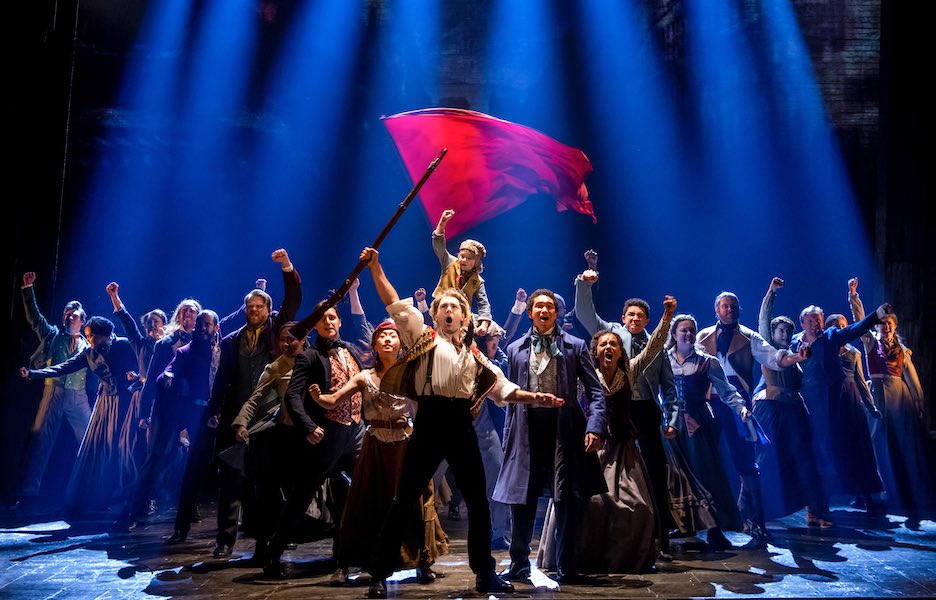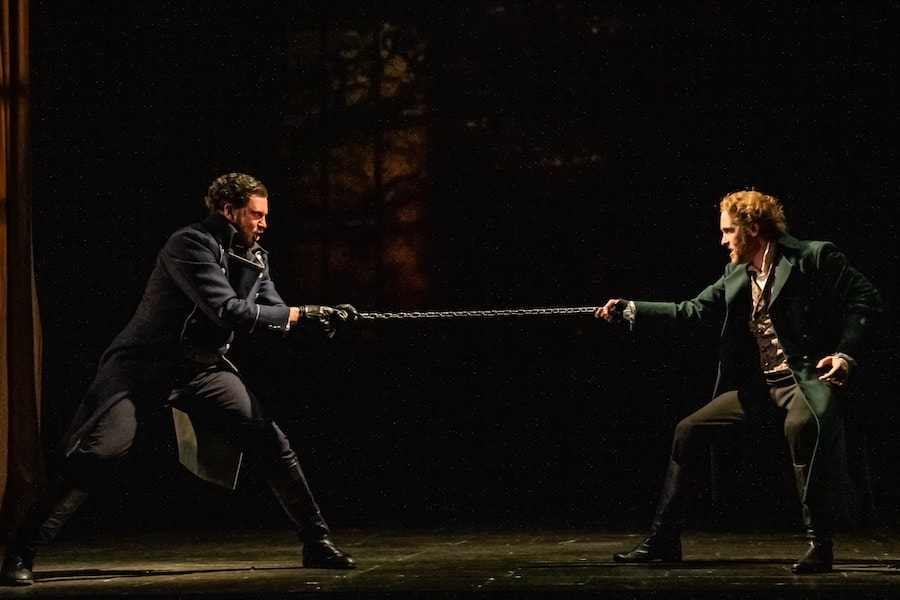Let it be acknowledged that Les Misérables is one of the world’s greatest musicals. I’ve seen it onstage in New York and London and on film, I’ve listened to the album on repeat, and every time the show is a revelation. With its stirring score, sweeping story, and peerless lyrics, Les Mis is unmissable. And happily, the production now encamped in the Opera House at Kennedy Center contains every centime of its magnificence.
Viewing this production, I marveled at how painterly the stage pictures are, and how cinematic the scene shifts, with chiaroscuro backgrounds in motion on scrims and ensembles costumed and lit like Rembrandt meets Bruegel. I thrilled to the sonorous voices and orchestra as they blended sublimely into rich choral sensations set off by sweet and soaring solos. I was touched by actors’ performances that felt found afresh in the moment. Even the extensive intimacy and fight choreography seemed dancerly.

There are so many things to praise about this work, not least the creatives behind it, beginning with the Victor Hugo novel, the Claude-Michel Schönberg book and music, the Herbert Kretzmer lyrics (see complete credits here — the touring company directed by Laurence Connor and James Powell has no weak links). There’s no end of salient things to say about the work’s resonance and execution. But the other night, one particular theme jumped out at me: Though the story is set in 19th-century France and intersects a historical revolution in the streets of Paris — Act Two begins spectacularly at the barricades — the heart of the musical, I realized, is an inner revolution: the epic arc of Jean Valjean’s redemption.

The Prologue establishes that Valjean is being released from 19 years of hard labor for stealing a loaf of bread. Never mind that it was an act of charity (the bread was to feed his sister’s child), Valjean reenters civilian life condemned by the law. And the disagreeable Inspector Javert, as agent of authoritarian justice, is not about to let Valjean forget it.
Then the story takes a stunning turn. Valjean, now a penniless ex-con, is caught stealing silver candle sticks from a church altar and is about to be sent back to prison. But the Bishop does a divine intervention: he assures the arresting officer that the silver was his gift to Valjean. By the grace of this Bishop (who would say it was the grace of God), Valjean is free to go. (“Rest from pain, and rest from wrong,” the Bishop sings to him.)
Thus is introduced dramatically the ancient tension between guilt and forgiveness, between punishment and mercy. And how Valjean now chooses to act knowing what’s at stake for him as a moral being is what propels much of the rest of the musical’s plot.
In time, Valjean assumes a new identity; he changes his name and becomes a factory owner and Mayor, and we see him do a series of good works. He rescues a destitute young woman named Fantine, promises to care for her daughter when she is dying (“Good m’sieur, you come from God in heaven,” Fantine sings to him). Then he saves a villager who was crushed beneath a cart (“Monsieur le Mayor, you come from God! You are a saint!” the villager sings to him).
But Valjean feels a sense of unworthiness that he can’t shake. “Men like you can never change,” Javert taunts him in a combative confrontation.

“Who am I?” is Valjean’s sung self-interrogation and is a recurring lyric, notably at a powerful point when Valjean learns that an innocent man who resembles him is going to be sent to prison for something Valjean did. The scene in which Valjean wrestles with what to do is riveting, and the conscience-stricken lyric is right up there with Hamlet’s “To be or not to be”:
Who am I?
Can I condemn this man to slavery?
Pretend I do not feel his agony?
This innocent who bears my face,
Who goes to judgement in my place…
Who am I?Can I conceal myself for ever more?
Pretend I’m not the man I was before?
And must my name until I die
Be no more than an alibi?Must I lie?
How can I ever face my fellow men?
How can I ever face myself again?My soul belongs to God, I know,
I made that bargain long ago.
He gave me hope when hope was gone!
He gave me strength to journey on!
Who am I?
At which point in the staging, Valjean bursts into the courtroom and declares himself:
Who am I?
I’m Jean Valjean!
There are many powerful scenes in Les Mis, but for me this one stands out because it most eloquently captures what the art form of theater can uniquely tell us about how who we are is in the ethics of our acts. And Jean Valjean’s inner revolution — his “Who am I?” character arc in search of moral selfhood — is a major reason this musical is so enduring and why it’s essential to see.
Running Time: Approximately two hours and 45 minutes, including one intermission.
Les Misérables plays to April 29, 2023, in the Opera House at the John F. Kennedy Center for the Performing Arts, 2700 F Street NW, Washington, DC. Tickets ($69–$225) are available at the box office, online, or by calling (202) 467-4600 or (800) 444-1324.
The program for Les Misérables is online here.
COVID Safety: Masks are optional in all Kennedy Center spaces for visitors and staff. If you prefer to wear a mask, you are welcome to do so. See Kennedy Center’s complete COVID Safety Plan here.




